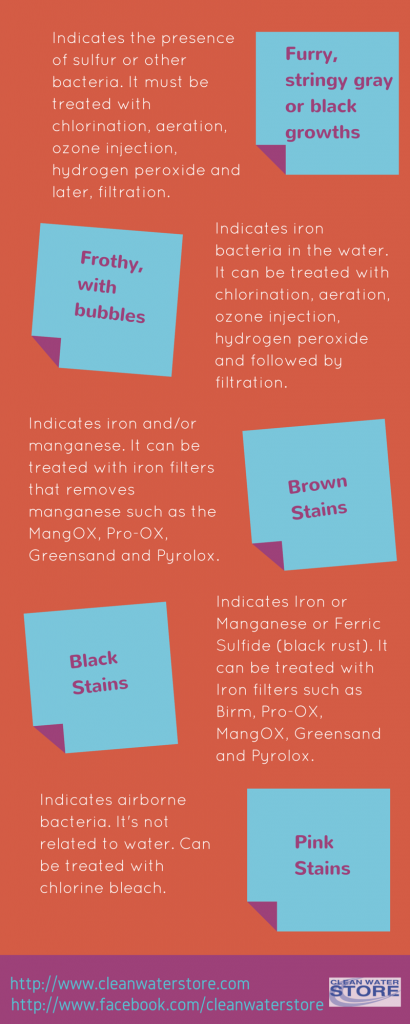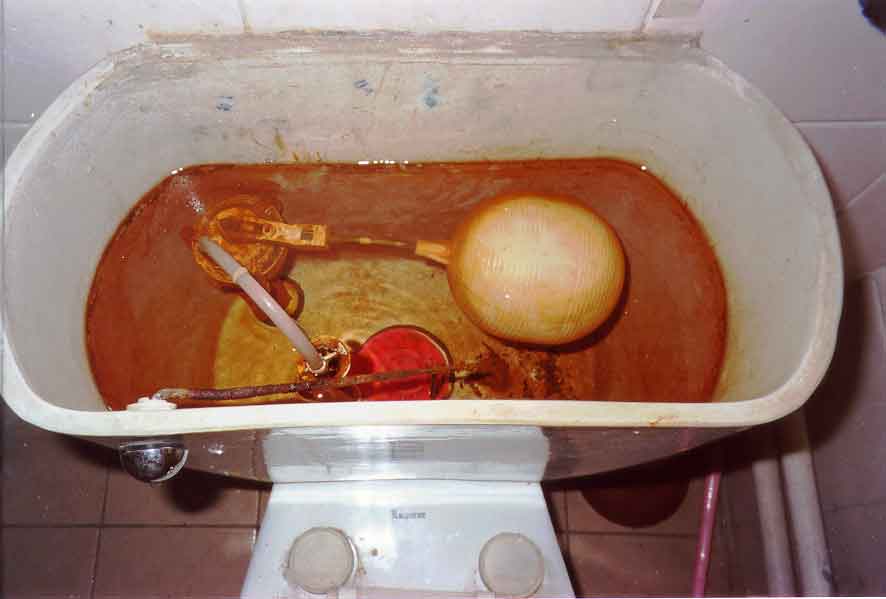Sediments, Stains and Water Sediment Filters 101
Sediments, Stains, and Water Sediment Filters 101
When your water system uses well water, it is important to do regular water testing to ensure that the water the well supplies is safe. Sometimes, bacteria, stains, and sediments can be found in the water. Water sediment filters won’t always take care of everything. For households reliant on a private well as their primary water source, using a sediment filter is essential to protect appliances and improve water quality.
Unlike city water, which is periodically tested and monitored by authorities, you handle the responsibility of monitoring your well water. When you know what’s in your water, you will be able to figure out the recommended treatment system to take care of it.
Before you try to understand the sediments and stains caused by your water, there are basic steps that you should know about. These are steps we follow in testing water. Keep in mind that there may be many steps you need to follow to treat your water before it becomes perfect for your home and family. The steps below cover the basics. These steps include:

Basic Steps in Well Water Treatment
- Test the chemistry of your well water. You must test for the presence of bacteria and other chemicals, especially if you live in an area where it’s possible for your water to be contaminated by chemicals. If you live near a factory, plant, gas station, or an agricultural area, there is a huge possibility that some of the chemicals used in those areas would find their way into your water source.
- Determine the flow rate of your water from your well. You should find out how many gallons of water per minute flow from your well into your household.
- Check your toilet tank. The sediments or stains you find there can be tell-tale signs of possible water problems.
- Check your water heater. Your water heater is one of the things in your home that gets exposed to water regularly. If there are any problems with your water quality, your water heater can reveal them all—or at the very least, provide strong clues.
- Check for water odors. You can check your water for odors when it’s cold and when it’s hot. There are times when the water will only exhibit an unpleasant odor when hot or cold, not both.
- Check for corrosion in your pipes. If you can find leaks and signs of corrosion, it’s certain that your problem has problems.
- Check for scale. Scale indicates the hardness of the water, which means you might also need to get your water treated.
- Identify the size of your pipes, specifically the size of your main pipe. You might need to install water treatment systems to improve the quality of your water, and you will need this information.
The step we will focus on is the third step. As you can see above, it is recommended that you check your toilet tank because what you find in there will tell you a lot about your water problems. Like the water heater, the toilet tank is a space regularly occupied by water. Whatever issues your water has will likely appear in your toilet tank. Here is a thorough guide on how to interpret the sediments and the stains that you find in your toilet tank.

What Sediments and Stains Tell You
- Floating white scales: If you notice white or gray scale buildup or floating flakes in your toilet tank, it may be due to hard water or high total dissolved solids (TDS). This buildup can affect plumbing and appliances. Depending on your water chemistry, a water softener or salt-free conditioner can reduce calcium hardness. If high TDS is the issue, a whole house reverse osmosis system may be needed for complete treatment.
- Rust Particles or Sand at the Bottom of a white flush tank: Seeing rust, sand, or blackish particles at the bottom of your toilet tank could indicate corroding galvanized pipes or sediment from your water source. If your pipes are corroding, consider replacing them and treating corrosive water with a neutralizer. A water sediment filter or iron filter is recommended for sand and sediment issues, depending on the type of particles present.
- Blue Stains: When blue stains appear in your tank, it’s highly likely that your water has a low pH level, which means that it is acidic. A calcite neutralizer or a soda ash feeder can easily resolve this issue.
- Rust Stains: The presence of rust stains means that there is an abnormal level of iron in your water. To get rid of these hideous stains, you can install an iron filter, and that’ll take care of it in a jiffy.
- Red, Stringy Growths: They look disgusting, we know, and if you ever see this inside your toilet tank, it means your water has sulfur, bacteria, or both. This problem can be solved using various methods, such as aeration, ozonation through ozone injection, chlorination, and hydrogen peroxide treatment. No matter what method you use, it is recommended that you have your water system filtered afterward.
- Frothy water with Bubbles: Another disgusting sight to behold. This usually means that iron bacteria are present in your water. You can follow the same water treatment method recommended for red stringy growths in the tank.
- Brown Stains: They look a bit rusty. Hence, it’s probably iron. Manganese can also cause this kind of staining. Sometimes, both are present in the water, resulting in these stains. It's ideal to use an iron filter that removes manganese at the same time.
- Black Stains: Black stains could still mean iron and manganese, but they could also be the presence of black rust (also called Ferric sulfide) in your water. A good iron filter can easily solve this problem, too.
- Pink Stains: This is usually caused by airborne bacteria, not water contamination. Chlorine bleach can prevent it from happening again.

What is a Sediment Filter?
A sediment filter is a type of water filter designed to remove particulate matter, such as dirt, sand, silt, and rust, from water. It is an essential component of a house sediment filtration system, as it helps to protect household appliances and plumbing from damage caused by sediment buildup. Sediment filters are typically used as a pre-filter to remove larger particles from the water, allowing other filters, such as carbon filters and reverse osmosis systems, to work more efficiently. By capturing these larger particles, sediment filters ensure that your water is cleaner and safer for everyday use, safeguarding your appliances and improving overall water quality.
How Sediment Filters Work
Sediment filters work by using a physical barrier to block particulate matter from passing through the filter. The filter is designed to capture particles of a certain size, typically measured in microns, and prevent them from entering the water supply. The filter may be made of a variety of materials, including paper, polyester, or polypropylene, and may be designed to capture particles as small as 1 micron. Some sediment filters can also remove other contaminants, such as chlorine and heavy metals, from the water. By effectively filtering out these particles and contaminants, sediment filters play a crucial role in maintaining clean water and protecting your household systems.
Common Types of Water Sediment Filters
Sediment filters help remove dirt, rust, and particles to improve water clarity and protect your plumbing. Here are the most common types:
-
Backwash Sediment Filters
Automatically removes dirt, rust, and fine particles without restricting flow. Many models filter down to 5 microns and only require media changes every 4–5 years. -
Micron-Rated Filter Cartridges
These cartridges remove particles based on size. For effective filtration, choose a micron rating that matches the sediment in your water. -
Centrifugal Sand Separators
Use centrifugal force to remove up to 98% of particles 74 microns or larger. No cartridges or media are needed, but manual flushing is required. -
Rusco Spin-Down Filters
Use a screen to trap sediments, which requires regular flushing. Choose a coarse mesh for longer filter life. Available in pleated, melt-blown, and string-wound options.
Choosing the Right Sediment Filter for Your House System
Choosing the right sediment filter for your house system depends on several factors, including the size of your household, the type of water supply you have, and the level of contamination in your water. Here are some key considerations:
- Micron Rating: The filter's micron rating determines the size of particles it can capture. A lower micron rating means the filter can capture smaller particles, providing finer filtration.
- Flow Rate: The filter's flow rate indicates how much water it can handle at one time. A higher flow rate is ideal for larger households or higher water usage.
- Filter Housing: The filter housing is the container that holds the filter. It should be durable and easy to clean, ensuring long-term reliability.
- Certifications: Look for certifications from reputable organizations, such as NSF International, to ensure the filter meets certain quality and performance standards.
Installing a Sediment Filter in Your House Sediment Filtration System
Installing a sediment filter in your house sediment filtration system is a relatively simple process. Follow these steps to ensure a successful installation:
- Turn off the water supply to the house to prevent any water flow during installation.
- Locate the filter housing and carefully remove the old filter.
- Install the new filter, making sure it is securely seated in the housing.
- Turn on the water supply and check for any leaks around the filter housing.
- Test the water quality to ensure the filter works properly and effectively removes sediment.
Following these steps ensures that your sediment filter is correctly installed and functioning as intended.
Maintenance and Replacement
Sediment filters require regular maintenance and replacement to continue working effectively. Here are some tips for maintaining and replacing your sediment filter:
- Check the filter regularly for signs of wear and tear, such as cracks or holes.
- To maintain optimal performance, replace the filter every 6-12 months or as recommended by the manufacturer.
- Clean the filter housing regularly to prevent the buildup of sediment and debris.
- Consider installing a filter with a built-in bypass valve to allow for easy maintenance and replacement without disrupting your water supply.
By following these tips, you can ensure that your sediment filter continues to provide clean, safe drinking water for your household, protect your appliances, and improve overall water quality.













